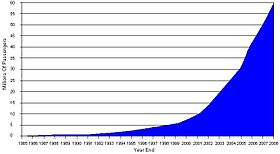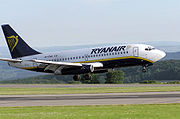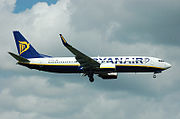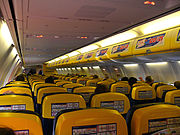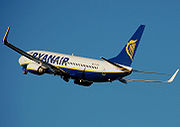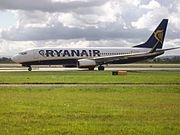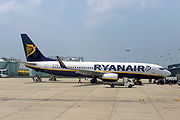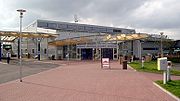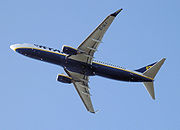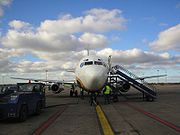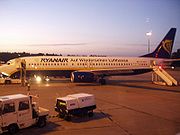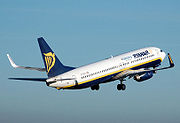
Ryanair
Did you know...
This Schools selection was originally chosen by SOS Children for schools in the developing world without internet access. It is available as a intranet download. Before you decide about sponsoring a child, why not learn about different sponsorship charities first?
| 280px | ||||
|
||||
| Founded | 1985 | |||
|---|---|---|---|---|
| Fleet size | 193 (+122 orders) | |||
| Destinations | 143 | |||
| Headquarters | Dublin Airport, Dublin, Ireland | |||
| Key people |
Michael O'Leary ( CEO) |
|||
| Website | www.ryanair.com | |||
Ryanair ( ISEQ: RYA, LSE: RYA, NASDAQ: RYAAY) is an Irish low cost airline, with headquarters at Dublin Airport and its largest operational bases at Dublin Airport and London Stansted Airport.
Ryanair operates over 190 Boeing 737-800 aircraft on 830 routes across Europe and North Africa from its 33 bases. The airline has been characterised by rapid expansion, a result of the deregulation of the air industry in Europe in 1992 and the success of its low cost business model. Ryanair is the third-largest airline in Europe in terms of passenger numbers and the world's largest in terms of international passenger numbers.
Financials and history
Financial overview
Ryanair has grown since its establishment in 1985, from a small airline flying a short hop from Waterford to London, into one of Europe's largest carriers. After taking the rapidly growing airline public in 1997, the money raised was used to expand the airline into a pan-European carrier. Revenues have risen from €231 million in 1998, to some €843 million in 2003 and net profits have increased from €48 million to €239 million, over the same period.
Half year profits for the period ended 31 October 2007, included ancillary revenue of €252 million. This activity was associated with the sale of car hire, hotels and travel insurance, as well as on board sales and excess baggage revenues. Ancillary revenue now accounts for just over 16% of total revenues.
Early years
Ryanair was founded in 1985 by Christy Ryan (after whom the company is named), Liam Lonergan (owner of an Irish tour operator named Club Travel) and noted Irish businessman, Tony Ryan, founder of Guinness Peat Aviation and father of Cathal Ryan and Declan. The airline began with a 15-seat Embraer Bandeirante turboprop aircraft, flying between Waterford and London Gatwick Airport with the aim of breaking the duopoly on London-Ireland flights at that time, held by British Airways and Aer Lingus.
In 1986, the company added a second route – flying Dublin- Luton International Airport, in direct competition to the Aer Lingus / BA duopoly for the first time. Under partial EU Deregulation, airlines could begin new international intra-EU services, as long as at least one of the two governments gave approval (the so-called "double-disapproval" regime). The Irish government at the time refused its approval, in order to protect Aer Lingus, but Britain, under Margaret Thatcher's pro-free-market Conservative government, approved the service. With two routes and two planes, the fledgling airline carried 82,000 passengers in one year.
Passenger numbers continued to increase, but the airline generally ran at a loss and by 1991, was in need of restructuring. Michael O'Leary was charged with the task of making the airline profitable. Ryan encouraged him to visit the USA to study the 'low fares/no frills' model being used by Southwest Airlines. O'Leary quickly decided that the key to low fares was to implement quick turn-around times for aircraft, "no frills" and no business class, as well as operating a single model of aircraft.
O'Leary returned, convinced that Ryanair could make huge inroads into the European air market, at that time dominated by national carriers, which were subsidised to various degrees by their parent countries. He competed with the major airlines by providing a "no-frills", low-cost service. Flights were scheduled into regional airports, which offered lower landing and handling charges than larger established international airports. O'Leary as Chief Executive did a publicity stunt, where he helped out with baggage handling on Ryanair flights at Dublin airport. By 1995, after the consistent pursuit of its low-cost business model, Ryanair celebrated its 10th birthday by carrying 2.25 million passengers.
1992 – 1999
In 1992, the European Union's (EU) deregulation of the air industry in Europe gave carriers from one EU country the right to operate scheduled services between other EU states and represented a major opportunity for Ryanair. After a successful floatation on the Dublin Stock Exchange and the NASDAQ Stock exchanges, the airline launched services to Stockholm, Oslo ( Sandefjord Airport, Torp, 110 km south of Oslo), Paris and Charleroi near Brussels. In 1998, flush with new capital, the airline placed a massive $2 billion order for 45 new Boeing 737-800 series aircraft.
2000 – 2006
The airline launched its website in 2000, with online booking initially said to be a small and unimportant part of the software supporting the site. Increasingly the online booking contributed to the aim of cutting flight prices by selling direct to passengers and excluding the costs imposed by travel agents. Within a year the website was handling three-quarters of all bookings. Today it is only possible to book seats via the website or via the "Ryanair direct" call-centre. No other possibilities are officially offered.
Ryanair launched a new hub of operation in Brussels South Charleroi Airport in 2001. Later that year, the airline ordered 155 new Boeing 737-800 series aircraft from Boeing at what was believed to be a substantial discount, (taking full advantage of the downturn in aeroplane orders after the slump in air travel following the September 2001 aircraft attacks in the United States) to be delivered over eight years from 2002 to 2010. Approximately 100 of these aircraft had been delivered by the end of 2005, although there were slight delays in late 2005 caused by production disruptions arising from a Boeing machinists' strike.
In 2002, Ryanair launched 26 new routes and established a hub in Frankfurt-Hahn Airport, its European expansion firmly on track.
In 2003, Ryanair announced the order of a further 100 new Boeing 737-800 series aircraft and in February, a third continental base was opened at Milan-Bergamo in Italy.
In April 2003, Ryanair acquired its ailing competitor Buzz from KLM at a knock-down price. Expansion continued with the launch of a base at Stockholm (Skavsta), Sweden. By the end of 2003, the airline flew 127 routes, of which 60 had opened in the previous 12 months.
The airline launched two more bases in the first half of 2004, at Rome (Ciampino) and Barcelona (Girona), increasing the total to 11 hubs.
During 2004, Michael O'Leary warned of a "bloodbath" during the winter from which only two or three low-cost airlines would emerge, the expectation being that these would be Ryanair and EasyJet. A modest loss of €3.3 million in the second quarter of 2004 was the airline's first recorded loss for 15 years. However, the airline immediately bounced back to ever greater profits afterwards. The enlargement of the European Union on 1 May 2004 opened the way to more new routes as Ryanair and other budget airlines tapped the markets of the EU accession countries.
In February 2005, Ryanair announced an order for a further 70 Boeing 737-800 aircraft, along with an option for a further 70. This was expected at the time to allow Ryanair to increase passenger numbers from the 34 million expected in 2005 to 70 million in 2011. Some of these aircraft would be deployed at Ryanair's 12 European hubs, others to 10 new hubs the company intended to establish over the next seven years.
In June 2006, the company announced that in the quarter ending 30 June 2006, its average yields were 13% higher than the same quarter of the previous year and its passenger numbers were up by 25% to 10.7 million, although year-on-year comparison was difficult, because of the movement of Easter from first quarter 2005 to second quarter 2006. Net profits (€115.7 m) increased by 80% over the same quarter in 2005. Management indicated that this level of growth may not be sustained for the remainder of this year, despite adding 27 new aircraft and opening new routes.
Ryanair's passenger numbers have grown by up to 25% a year for most of the last decade. Carrying under 0.7 million annually in its early years, passenger figures grew to 21.4 million in 2003. The rapid addition of new routes and new hubs has enabled this growth in passenger numbers and Ryanair is now among the largest carriers on European routes. In August 2004, the airline carried 20% more passengers within Europe than British Airways.
Ryanair posted record half-year profits of €329 million for the six months ending 30 September 2006. Over the same period, passenger traffic grew by more than a fifth to 22.1 million passengers and revenues rose by a third to €1.256 billion.
Aer Lingus takeover bid
On 5 October 2006, Ryanair launched a €1.48 billion (£1bn; $1.9bn) bid to buy fellow Irish carrier Aer Lingus. Ryanair CEO Michael O'Leary said the move was a “unique opportunity” to form an Irish airline. The "new" airline would carry over 50 million passengers a year.
Aer Lingus floated on the Irish Stock Exchange on 2 October 2006, following a decision by the Irish government to sell more than 50% of its 85.1% share in the company. Workers retained a 15% stake. The shares began trading at €2.20 each, valuing the firm at €1.13bn. Ryanair said it had bought a 16% stake in Aer Lingus and was offering €2.80 per share for remaining shares. On the same day, Aer Lingus rejected Ryanair's takeover bid, saying the bid was contradictory. With a total of 47% of Aer Lingus in the hands of the Irish Government, the employee share ownership trust and other entities that publicly rejected the bid and a further 4% in the hands of the Bank of Ireland and AIB, who were considered highly unlikely to sell, the takeover bid was effectively dead. The Ryanair website described the attempted takeover as, "In October...we make an all cash offer for the small regional airline, Aer Lingus".
2007
Fourth quarter 2006 profits far exceeded analyst expectations and over the period from October 2006 to February 2007, the stock rose by some 50%. The press suggested that Ryanair is now selling on its 737-800s at higher prices than the cost of acquisition from Boeing. They also noted that average fares keep increasing.
| “ | In contrast to its popular advertising messages and regular free seat sales, the airline's average fares have been rising for three years | ” |
|
—Financial Times, |
||
In January, following a BBC investigation, Ryanair conceded that a claim it had cut its CO2 emissions by half in recent years was "an error".
In the meantime, Ryanair started its flight operations to the island of Malta, from Dublin, Luton and Pisa. New bases have been created at Bremen (April), Weeze (June), Bristol (November), Alicante, Valencia and Belfast George Best.
In May, Ryanair launched BING. This application brings daily fare specials to the user's computer.
On 16 May, Ryanair launched a seat sale with fees, taxes and charges waived. A small number of destinations, including Dublin, were offered with 1 million seats for 1 penny or 1 Euro cent. Ryanair's website crashed, as it received four million hits from bargain hunters. The sale lasted until the following Monday, with just over half a million free seats taken up.
On 18 July, the British Advertising Standards Authority (ASA) ordered Ryanair not to repeat a claim that airline industry "accounts for just 2% of carbon dioxide emissions". The ASA ruled it breached rules on truthfulness by not explaining the figure was based on global, rather than UK emissions (which are 5.5% of the total) and exclude incoming flight figures.
In August, the company announced it would start charging passengers to check-in at the airport, therefore reversing its policy of paying for online check-in. It says that by cutting airport check-in it reduces overhead costs.
New long haul airline
Ryanair's CEO, Michael O'Leary, stated in April 2007 that Ryanair plans to launch a new long haul airline around 2009. The new airline would be separate from Ryanair and operate under a different branding. It would offer both low cost and a first class service, intended to rival airlines like Virgin Atlantic. The new airline would operate from Ryanair's existing bases in Europe, to approximately six new bases in the United States. The new American bases will not be main hubs such as New York's JFK airport, but smaller airports located outside major cities. It is planned that the new airline will eventually operate a fleet of 40 to 50 new Airbus A350 XWB or Boeing 787 aircraft. Since the Boeing 787 is sold out of production, until at least 2012 and the Airbus A350 XWB will not enter service until 2013, this would contribute a delay to the airline's launch. It was not stated if other aircraft would be operated in the interim. O'Leary indicated that he intends to purchase the aircraft, when market prices for new aircraft recede, according to demand. It is said that the name of the new airline will be RyanAtlantic and will sell tickets through the Ryanair website under an alliance agreement.
2008
On 31 August 2008 the Sunday Times reported that Ryanair was saving money by pressuring pilots to limit their discretionary fuel reserves. The discretionary reserves are in addition to the legal requirement for 5% extra fuel to be carried as a contingency, plus adequate fuel reserves to divert to an alternative airport, plus enough fuel to hold for 30 minutes at the destination airport. Ryanair has already suffered one incident in the past three years due to a low fuel situation. This type of move was popular at all airlines because of the high cost of fuel in the Summer of '08. Carrying less reserves allows the plane to get better mileage than when it is overloaded with the excess weight of unused fuel.
In October, Ryanair withdrew operations from a base in Europe for the first time. Ryanair was unable to reach agreement with the local authorities in Valencia, Spain, thus terminating many of its Valencia services after a year of operation, though some routes still remain open. It is estimated the closure cost 750 jobs.
In November, Ryanair announced that they were planning to offer United States bound flights for around 10 euros by the end of 2009. Such a move would still need to be negotiated and the relevant permissions obtained.
In December, Ryanair carried out its threat to close all its routes to and from Fuerteventura, in the Canary Islands.
Second Aer Lingus takeover bid
On 1 December 2008, Ryanair launched a second takeover bid of fellow Irish airline, Aer Lingus. Offering an all-cash offer of €748 million (£619mil; $950mil). The offer was a 28% premium on the value of Aer Lingus stock, during the preceding 30 days. Ryanair said, "Aer Lingus, as a small, stand alone, regional airline, has been marginalised and bypassed, as most other EU flag carriers consolidate." The two airlines would operate separately. Ryanair stated that they would double the Aer Lingus short haul fleet from 33 to 66 and create 1,000 new jobs. The Aer Lingus Board rejected the offer and advised its shareholders to take no action. On 22 January 2009, Ryanair walked away from the Aer Lingus takeover bid after it was rejected by the Irish Government on the grounds that it undervalued the airline and would harm competition.
2009
On 21 February 2009 it was confirmed by Ryanair that they were planning to close all check-in desks by the start of 2010. Michael O'Leary, Ryanair's chief executive said that passengers will be able to leave their luggage at a bag drop but otherwise everything will be done online.
Business model
Ancillary revenue and in-flight service
Much of Ryanair's revenue is generated from ancillary revenue, that is income from other sources than ticket fares. In 2009 ancillary revenue was at €598 million, compared to a total revenue of €2,942 million.
Ryanair has been described by the consumer magazine, Holiday Which?, as being the "worst offender" for charging for optional extras. As part of the low-cost business model the airline charges fees, these can be related to alternate services like using airport check-in facilities instead of the the online service fee and using non-prefered methods of payment. It also charges for extra services like checked in luggage and it offers food and drinks for purchase as part of a buy on board programme. Ryanair argues that it charges for a large number of optional extras in order to allow those passengers who do not require baggage, priority boarding or other premium services to travel for the lowest possible price by giving customers the flexibility to choose what they pay for.
In 2009 Ryanair abolished airport check-in and replaced it with a fast bag drop for those passengers checking in bags. The option of checking in at the airport for €10 has been discontinued and all passengers are required to check-in online and print their own boarding pass. Passengers arriving at the airport without a pre-printed online check-in will have to pay €40 for their boarding pass to be re-issued. Ryanair have also replaced the free online check-in with a €5 online check-in fee which is charged per person, per flight. Although this fee is waived on “Free”, “€1” and “€5” promotional fares, it has been critised as being a non-optional extra charge which should be included in the headline fare.
No-frills
New Ryanair aircraft have been delivered with leather seats which do not recline, no seat-back pockets, safety cards stuck on the back of the seats and life jackets stowed overhead rather than under the seat. This allows the airline to save on aircraft costs and enables faster cleaning and safety checks during the short turnaround times. It was reported in various media that Ryanair wanted to order their aircraft without window shades; however, the new aircraft do have them as it is required by the regulations of the Irish Aviation Authority.
From time to time, Ryanair suggest outlandish ideas to further reduce costs. Generally these ideas are designed to generate free publicity for the airline and they would be impractical to implement. Proposed measures to reduce frills further have included eliminating two toilets to add six more seats, charging for the use of the toilet, redesigning the aircraft to allow standing passengers, charging extra for overweight passengers, asking passengers to carry their checked-in luggage to the plane, or even seats if they can get clearance "to allow passengers to stand on its flights".
Unlike many other airlines Ryanair are a strictly point-to-point carrier and do not offer connecting flights. Passengers who purchase an onward flight from their destination, intending to make a connection, are held responsible for making it to the airport on time for each flight. In line with the majority of airlines, Ryanair does not compensate passengers who miss their flights because they arrive too late at the airport nor does it provide replacement tickets free of charge. If a passenger misses their flight then it is the passenger's responsibility to buy a new ticket at the their own expense. This rule applies regardless of the passenger's chosen method of transport to the airport (including another Ryanair flight).
Customer service
Ryanair has been criticised for many aspects of its customer service. The Economist newspaper wrote that Ryanair's "cavalier treatment of passengers" had given Ryanair "a deserved reputation for nastiness" and that the airline "has become a byword for appalling customer service ... and jeering rudeness towards anyone or anything that gets in its way". In 2002, the High Court in Dublin awarded Jane O'Keefe €67,500 damages and her costs after Ryanair reneged on a free travel prize she was awarded for being the airline's 1 millionth passenger.
The airline has come under heavy criticism in the past, for its poor treatment of disabled passengers. In 2002, it refused to provide wheelchairs for disabled passengers at London Stansted Airport, greatly angering disabled rights groups. The airline argued that this provision was the responsibility of the airport authority, stating that wheelchairs were provided by 80 of the 84 Ryanair destination airports, at that time. A court ruling in 2004 judged that the responsibility should be shared by the airline and the airport owners; Ryanair responded by adding a surcharge of £0.50 to all its flight prices.
Ryanair does not offer customers the possibility of contacting them by email or webform, only through a premium rate phone line, by fax or by post. An Early day motion in the British Parliament put forward in 2006 criticised Ryanair for this reason and called on the company to provide customers with a means to contact the company by e-mail. Some people claim that Ryanair is therefore flouting UK E-commerce Regulations, which state that the email address of the service provider must be given.
Publicity
Controversial advertising
Ryanair's advertising is deliberately controversial, in order to generate additional free publicity for the airline. This has led to a number of complaints to the Advertising Standards Authority (ASA) and occasionally court action being taken against the airline..
Another Ryanair tactic is to make deliberately controversial statements to gain media attention. An example of this was the live BBC News interview on 27 February 2009 when Michael O'Leary, observing that it was "a quiet news day", commented that Ryanair was considering charging passengers £1 to use the toilet on their flights. The story subsequently made headlines in the media for several days and drew attention to Ryanair's announcement that it was removing check-in desks from airports and replacing them with online check-in. Eight days later O'Leary eventually admitted that it was a publicity stunt saying "It is not likely to happen, but it makes for interesting and very cheap PR". It is perhaps a demonstration of the public's expectations of Ryanair that the concept of paying for even this most essential of extras was foreseen by the spoof news website "The Mardale Times" some 5 months previously, in their article "Ryanair announce new 'Pay-Per-Poo' service".
Ryanair often use their advertising to make direct comparisons and attack their competitors. One of their advertisements used a picture of the Manneken Pis, a famous Belgian statue of a urinating urchin, with the words: "Pissed off with Sabena's high fares? Low fares have arrived in Belgium." Sabena sued and the court ruled that the advertisements were misleading and offensive. Ryanair was ordered to discontinue the advertisements immediately or face fines. Ryanair was also obliged to publish an apology and publish the court decision on their website. Ryanair used the apologies for further advertising, primarily for further price comparisons.
Another deliberately provocative ad campaign compared Ryanair with British Airways. As with Sabena, British Airways disagreed with the accompanying price comparisons and brought legal action against Ryanair. However, in this case the High Court sided with Ryanair and threw BA's case out ordering BA to make a payment towards Ryanair's court costs. The judge ruled "The complaint amounts to this: that Ryanair exaggerated in suggesting BA is five times more expensive because BA is only three times more expensive. Accordingly, in my view, the use was honest comparative advertising. I suspect the real reason that BA do not like it is precisely because it is true."
Inuenndo often features in Ryanair advertisements with one ad featuring a model dressed as a schoolgirl, accompanied by the words "Hottest back to school fares". Ryanair ran the advertisement in two Scottish and one UK-wide newspaper. After receiving 13 complaints, the advertisement was widely reported by national newspapers, generating more free publicity for the airline. The Advertising Standards Authority (ASA) instructed them to withdraw the advert in the United Kingdom, saying that it "appeared to link teenage girls with sexually provocative behaviour and was irresponsible and likely to cause serious or widespread offence". Ryanair said that they would "not be withdrawing this ad" and would "not provide the ASA with any of the undertakings they seek", on the basis that they found it absurd that "a picture of a fully clothed model is now claimed to cause 'serious or widespread offence', when many of the UK's leading daily newspapers regularly run pictures of topless or partially dressed females without causing any serious or widespread offence".
Allegations of misleading advertising
Ryanair was ordered by the ASA to stop claiming that its flights from London to Brussels are faster than the rail connection Eurostar, on the grounds that the claim was misleading, due to required travel times to the airports mentioned. Ryanair stood by its claims, noting that their flight is shorter than the train trip and that travel time is also required to reach Eurostar's train stations.
In April 2008, Ryanair faced a probe by the UK Office of Fair Trading, after a string of complaints about its adverts. It was found to have breached advertising rules seven times in two years. ASA's director general Christopher Graham commented that formal referrals to the OFT were rare, the last occurring in 2005. He added that the ASA "would prefer to work with advertisers within the self-regulatory system rather than call in a statutory body, but Ryanair's approach has left us with no option." Ryanair countered with the claim that the ASA had "demonstrated a repeated lack of independence, impartiality and fairness".
In July 2009, Ryanair took a number of steps to "increase the clarity and transparency of its website and other advertising" after reaching an agreement with the OFT. The airline's website now includes a statement that "Fares don't include optional fees/charges" and they now include a table of fees to make fare comparisons easier.
Safety
While there have been concerns over long hours for pilots impacting safety, O'Leary called safety a top priority for the airline. Ryanair has never had a fatal accident.
See Also: Accidents and incidents.
Dispatches programme
On 13 February 2006, Channel 4 broadcast a documentary as part of its Dispatches series, "Ryanair caught napping". Two undercover reporters obtained jobs as cabin crew, based at Ryanair's operations at London Stansted Airport and spent 5 months secretly recording the training programme and cabin crew procedures. The documentary criticised Ryanair's training policies, security procedures, aircraft hygiene and highlighted poor staff morale. It claims to have filmed Ryanair cabin crew sleeping on the job; using aftershave to cover the smell of vomit in the aisle, rather than cleaning it up; ignoring warning alerts on the emergency slide; encouraging staff to falsify references for airport security passes; and asking staff not to recheck passengers' passports before they board flights. Staff in training were allegedly falsely told that any Boeing 737-200 (now no longer in service with Ryanair) impact would result in the death of the passenger sitting in seat 1A and that they should not pass this information on to the passenger.
Ryanair denied the allegations and published its correspondence with Dispatches on its website. Ryanair provided detailed written responses to show that there is no substance to these allegations and requested Dispatches to provide evidence supporting its claims. However, Dispatches failed to do so. Ryanair forwarded all twenty allegations to both the British and Irish aviation authorities, both of whom agreed that there was no substance to them. It also alleged that the programme was misleading and that promotional materials, in particular a photograph of a stewardess sleeping, had been faked by Dispatches. Furthermore, Dispatches rejected Ryanair's repeated offers of a live interview or an unedited recorded interview to allow Ryanair to respond fully in the programme to these unsubstantiated allegations. See Also accidents and incidents.
Competitors
Ryanair now has a number of low-cost competitors. In 2004, approximately 60 new low-cost airlines were formed. Although traditionally a full-service airline, Aer Lingus moved to a low-fares strategy from 2002, leading to a much more intense competition with Ryanair on Irish routes.
Airlines which attempt to compete directly with Ryanair are treated harshly, with Ryanair reducing fares to significantly undercut their competitors. In response to MyTravelLite, who started to compete with Ryanair on the Birmingham to Dublin route in 2003, Ryanair set up competing flights on some of MyTravelLite's routes until they pulled out. Go was another airline, which attempted to offer services from Ryanair's hub at Dublin to Glasgow and Edinburgh in Scotland. A fierce battle ensued, which ended with Go withdrawing its service from Dublin.
In September 2004, Ryanair's biggest competitor, EasyJet, announced routes to the Republic of Ireland for the first time, beginning with the Cork to London Gatwick route. Until then, easyJet had never competed directly with Ryanair on its home ground. Easyjet announced in July 2006, that it was withdrawing its Gatwick-Cork, Gatwick-Shannon and Gatwick-Knock services; within two weeks, Ryanair also announced it would withdraw its own service on the Gatwick-Knock and Luton-Shannon routes.
Ryanair has asked the high court to investigate why it has been refused permission to fly from Knock to Dublin. This route was won by CityJet, which was unable to operate the service. The runner up, Aer Arann, was then allowed to start flights, a move Ryanair criticises on the basis that not initiating an additional tender process was unlawful.
DFDS Seaways cited competition from low-cost air services, especially Ryanair, which now flies to Glasgow Prestwick Airport and London Stansted Airport from Gothenburg City Airport, as the reason for scrapping the Newcastle-Gothenburg ferry service in October 2006. It was the only dedicated passenger ferry service between Sweden and the United Kingdom and had been running since the 19th century, under various operators.
Choosing destinations
Ryanair negotiates extremely aggressive contracts with its airports, demanding very low landing and handling fees, as well as financial assistance with marketing and promotional campaigns. In subsequent contract renewal negotiations, the airline plays airports off against each other, threatening to withdraw services and deploy the aircraft elsewhere, if the airport does not make further concessions. In April 2006, a failure to reach agreement on a new commercial contract resulted in Ryanair announcing that it would withdraw service on the Dublin–Cardiff route at short notice. The airport management rebutted Ryanair's assertion that airport charges were unreasonably high, noting that the Cardiff charges were already below Ryanair's average and claimed that Ryanair had recently adopted the same negotiating approach with Cork Airport and London Stansted Airports. Ryanair was forced to give up its Rome Ciampino– Alghero route, after the route was allocated to Air One, as a Public Service Obligation (PSO) route. The European Commission is investigating the actions of the Italian Government in assigning PSO routes and thus restricting competition.
Destinations
Ryanair's main airports are in Dublin and London Stansted.
Destination airports are often secondary airports such as Paris Beauvais as opposed to Paris CDG or Paris Orly. Indeed London Stansted was a secondary London airport prior to Ryanair's arrival.
Ryanair has over 30 European 'bases'. While these airports feature prominently on the Ryanair website, some non-base airports actually serve more destinations than some of the base airports, for example non-base City of Derry and Knock airports have more destinations (both six) than other base airports such as Belfast City or Cork (both five destinations) and Kerry (four destinations). Oslo-Torp even has sixteen destinations, Venice-Treviso has seventeen and Palma-Mallorca has eighteen all as non-base airports. In France, Paris Beauvais has nineteen routes, and despite Ryanair operating from 23 airports there, only one of them, Marseille, is a base.
Fleet
All aircraft in the Ryanair fleet have either been retrofitted with performance enhancing winglets or the more recent deliveries have them fitted as standard. Ryanair are expanding rapidly and will operate a fleet of 292 aircraft by 2012 with options for a further 10 aircraft to be delivered during that time.
Ryanair claim to operate the newest, greenest and quietest fleet of aircraft in Europe.
As of June 2009, the Ryanair fleet average age was 3.1 years. and consists of the following aircraft:
| Aircraft | Total in service | Orders | Options | Passengers |
|---|---|---|---|---|
| Boeing 737-800 | 193 | 122 | 84 | 189 |
- Various liveries:
- Standard new livery: EI-DCB
- Standard old livery: EI-CSN
- Dreamliner scheme: EI-DCL
- Pride of Scotland: EI-DAO
- Nein Zum Lufthansa Kerosinzuschlag: EI-DAD
- Say NO to BA fuel Levy: EI-CTB
- Arrivederci Alitalia: EI-CSZ
- Bye Bye SkyEurope: EI-DLF
- Nyköping: EI-CSV
- Catalunya: EI-CSW
- Żegnamy PLL LOT: EI-DLG
- Bye Bye Latehansa : EI-DLM
- Bye Bye Baby : EI-DLN
- Bye Bye EasyJet : EI-DLO
- City of Nyköping : EI-DAF
Future purchases
In August 2008, Ryanair confirmed that they were in talks with Boeing and Airbus about an order, which could include up to 400 aircraft. Even though Ryanair has dealt with Boeing aircraft up to this point, Michael O'Leary said "it is also manageable for us to give the order to Airbus." The aircraft from this order could start being delivered in 2013, as soon as the current order book expires. The impact of the order would depend on the pace at which the aircraft are delivered.
In February 2009, Airbus said they had no plans to enter a costly and time-consuming sales campaign with Ryanair, due to the large discounts demanded by the airline.
Past fleet
Ryanair has operated the following types of aircraft:
| Aircraft | Introduced | Retired |
|---|---|---|
| Embraer EMB 110 Bandeirante | 1985 | 1989 |
| Hawker Siddeley HS 748 | 1986 | 1989 |
| BAC One-Eleven | 1987 | 1994 |
| ATR 42 | 1989 | 1991 |
| Boeing 737-200 | 1994 | 2005 |
Accidents and incidents
According to its Chief Executive, Ryanair considers safety a top priority and has never been involved in a fatal accident or an accident involving serious injury.
- On 27 February 2002, Ryanair Flight 296, from Dublin to London Stansted, was evacuated shortly after landing in Stansted, because airport personnel believed that one of the engines was on fire. The UK Air Accidents Investigation Branch concluded that the release of oil from a broken engine bearing into the path of hot gas had caused the smoke and that there were no signs of fire damage. The investigation also found that although the aircraft was fully evacuated within 90 seconds, some members of the cabin crew struggled to open the emergency doors and had to be assisted by off-duty cabin crew traveling as passengers. Some passengers attempted to evacuate onto the right wing of the aircraft, before being turned back by firefighters. The investigation found that during training, cabin crew were informed that in an emergency, the doors are more difficult to open due to the need to activate the evacuation slides, but the majority of trainees never experienced the pressure needed. The investigation also made several recommendations to the Civil Aviation Authority, on how to better handle similar incidents in the future.
- On 10 November 2008, Ryanair Flight 4102, from Frankfurt-Hahn Airport, suffered undercarriage damage in an emergency landing at Rome Ciampino Airport, after experiencing multiple bird strikes, which damaged both engines on approach. The registration number of the aircraft involved was: EI-DYG. There were 6 crew and 166 passengers on board. Two crew and eight passengers were taken to hospital with minor injuries. The port undercarriage of the Boeing 737-8AS collapsed, leaving the aircraft stranded on the runway and closing the airport for over 35 hours. As well as damage to the engines and undercarriage, the rear fuselage was also damaged by contact with the runway. Ryanair thanked the crew of Flight 4102 and praised their skill and professionalism, at a dinner held in Frankfurt.
